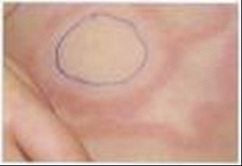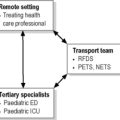5.6 Acute rheumatic fever
Introduction
Examination
The diagnosis of ARF relies upon the identification of specific clinical features. The National Heart Foundation of Australia has developed diagnostic criteria which depend on the stratification of patient risk (Table 5.6.1). High-risk groups are those who live in communities with high rates of ARF or RHD such as Aboriginal and Torres Strait Islanders.
Polyarthritis, aseptic monoarthritis, or polyarthralgia
Erythema marginatum
Subcutaneous nodules
Chorea
Polyarthritis
Erythema marginatum
Subcutaneous nodules
Chorea
ESR >30 mm hr–1 or CRP >30 mg L–1
Prolonged PR interval on ECG
ESR >30 mm hr–1 or CRP
>30 mg L–1
Prolonged PR interval on ECG
Polyarthralgia or aseptic monoarthritis
Amended from National Heart Foundation of Australia; Diagnosis and management of acute rheumatic fever and rheumatic heart disease in Australia – an evidence-based review. 2006.
Skin
Erythema marginatum
Erythema marginatum is a distinctive feature of rheumatic fever, but is only found in approximately 10% of patients. Lesions usually begin as small, pink, non-pruritic macules or papules on the trunk or limbs. The lesions gradually spread to develop a raised pink serpiginous edge with central clearing and remain late into the course of illness (Fig. 5.6.1).
Investigations
Laboratory
Evidence of GAS infection
Preceding GAS infection should be demonstrated using a positive throat culture, rapid antigen detection test or elevated or rising anti-streptococcal antibody titre. Antibodies rise in the first month post-infection, plateau at 3–6 months, and normalise after 6–12 months (Table 5.6.2).
Amended from National Heart Foundation of Australia; Diagnosis and management of acute rheumatic fever and rheumatic heart disease in Australia – an evidence-based review. 2006.
Treatment
Prevention and prophylaxis
Continuous anti-streptococcal prophylaxis is recommended in all patients with a documented history of ARF to prevent recurrence with subsequent GAS infections. The National Heart Foundation of Australia recommends benzathine benzylpenicillin 450 mg IM (<20 kg) or 900 mg IM (>20 kg) every 4 weeks (or 3 weeks for selected high-risk groups). Oral phenoxymethylpenicillin 250 mg q12h may be used but is associated with poorer compliance and efficacy. In cases of penicillin sensitivity alternatives include oral erythromycin. Duration of therapy should be a minimum of 10 years after the most recent episode of ARF or until age 21 years. Prolonged therapy may be required for moderate to severe RHD and should be discussed with experts. Endocarditis prophylaxis is mandatory for those with residual valve disease (see Chapter 5.7 on Infective Endocarditis).
Carapetis J.R., Brown A., Wilson N.J., Edwards K.N., Rheumatic Fever Guidelines Writing Group. An Australian guideline for rheumatic fever and rheumatic heart disease: an abridged outline. Med J Aust. 2007;186(11):581-586.
Currie B.J., Brewster D.R. Rheumatic fever in Aboriginal children. J Paediatr Child Health. 2002;38(3):223-225.
National Heart Foundation of Australia (RF/RHD guideline development working group) and the Cardiac Society of Australia and New Zealand. Diagnosis and management of acute rheumatic fever and rheumatic heart disease in Australia – an evidence-based review. 2006.
Steer A.C., Carapetis J.R., Nolan T.M., Shann F. Systematic review of rheumatic heart disease prevalence in children in developing countries: The role of environmental factors. J Paediatr Child Health. 2002;38(3):229-234.
Stollerman G.H. Rheumatic fever. Seminar. Lancet. 1997;349(9056):935-942.
Therapeutic Guidelines: Rheumatology, version 1. Therapeutic Guidelines Limited, 2006.
Wilson N.J., Neutze J.M. Echocardiographic diagnosis of subclinical carditis in acute rheumatic fever. Int J Cardiol. 1995;50:1-6.




